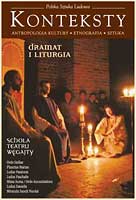Kunicza – wieś staroobrzędowców w Mołdawii
The Tradition of the Old Believers
Author(s): Svetlana ButskayaSubject(s): Anthropology
Published by: Instytut Sztuki Polskiej Akademii Nauk
Keywords: anthropology of theatre; liturgy; tradition
Summary/Abstract: An account of the most important aspects of on-the-spot work conducted in the village of Kunicha. The objective of the research was a complex study of the traditional culture of the Old Rite community living in Moldova. The seventeenth-century schism in the Russian Orthodox Church, which was the outcome of the reforms introduced by Tsar Alexey I and Patriarch Nikon remains one of the most dramatic pages in Russian history. The raskoniki (raskol – schism), persecuted by the state and the official Church, tried to preserve not only their faith but also their very lives. Entire settlements, villages and families took Church books, manuscripts and icons along with them while seeking refuge in dense forests along the borders of Russia and even abroad. Many found safety in the lands of pre-partition Commonwealth. Today, Old Believer settlements may be encountered all over the world – in Baltic countries, Romania, Moldova, Turkey, the USA and Canada. The earliest Old Believer settlements in Moldavia (today: Moldova) were founded in the first half of the eighteenth century. Up to this day, Old Believer Russian villages coexist with those of an entirely different cultural tradition and tongue. Assimilation, however, never took place: the Old Believers vigilantly protect the spiritual message of their ancestors. The Moldavian environment treats the Russians with respect, and accepts the complexity of their nature – enclosure within their tradition and an unwillingness to establish closer contacts; both attitudes are associated with a specific historical plight. During the early 1970s the prosperous and large village of Kunicha was inhabited by more than 4 000 Old Believers. Although the young people tend to leave for the cities, generally speaking the bond with the land of the fathers remains undisturbed, as evidenced by the gatherings of whole families for assorted important holidays, especially Christmas and Easter. The necessity to adapt to a constantly changing social situation is one of the many aspects of the daily life of the village. Openness to transformations is a feature only of economic activity. At the same time, the life of the villagers is still marked by Church festivities and rituals, and the community functions predominantly in a sacral time, closely subjected to the daily and yearly liturgical cycle of Church services. Throughout the whole liturgical year Kunicha resounds with a one-voice znamienniy chant, recorded in a special neumatic notation, similar to the medieval tradition of Western Europe. The Old Believers did not accept the record introduced by Patriarch Nikon – with square notes and polyphony – and continue singing according to the old books. Today, the inhabitants of Kunicha are not forced to flee their foes. The Eastern rite, Ukrainian part of the village respects neighbours who cultivate different customs. Young people from the two parts of the village attend the same school, and from early childhood are taught deferen
Journal: Konteksty
- Issue Year: 2007
- Issue No: 02
- Page Range: 69-73
- Page Count: 5
- Language: Polish
- Content File-PDF

